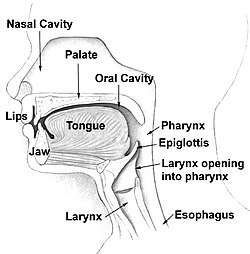They are hollow spaces that change the quality of the sounds. The human speech mechanism has three resonators - the pharynx, which can change its shape slightly; the nasal cavity, which is constant in shape and size, and the oral cavity, which is extremely variable.
4. The pharynx
It's the passage situated at the top of the larynx, communicating with the oral and nasal cavities. Its front wall is formed by the roof of the tongue. The nasal cavity extends from the pharynx to the nostrils, and is separated from the oral cavity by the palate. The entrance to the nasal cavity is the most important resonator, due to the great mobility of its organs and subsequent changes in size and shape. The base of the oral cavity is occupied by the tongue, and the front limited by the lips.

5. Nasal cavity
The nasal cavity (or nasal fossa) is a large air filled space above and behind the nose in the middle of the face.
Function
The nasal cavity conditions the air to be received by the other areas of the respiratory tract. Owing to the large surface area provided by the nasal conchae, the air passing through the nasal cavity is warmed or cooled to within 1 degree of body temperature. In addition, the air is humidified, and dust and other particulate matter is removed by vibrissae, short, thick hairs, present in the vestibule. The cilia of the respiratory epithelium move the particulate matter towards the pharynx where it passes into the esophagus and is digested in the stomach.
Walls
The lateral wall of the nasal cavity is mainly made up by the maxilla, however there is a deficiency that is compensated by: the perpendicular plate of the palatine bone, the medial pterygoid plate, the labyrinth of the ethmoid and the inferior concha.
The nasal cavity is enclosed by the nasal bone above.
The floor of the nasal cavity, which forms the roof of the mouth, is made up by the bones of the hard palate: the horizontal plate of the palatine bone posteriorly and the palatine process of the maxilla anteriorly. To the front of the nasal cavity is the nose, while the back blends, via the choanae, into the nasopharynx. The paranasal sinuses are connected to the nasal cavity through small orifices called ostia.

6. The Oral
Cavity
- The oral cavity (mouth) consists of two parts: the vestibule and the mouth proper.
- The vestibule is the slit-like spaced between the cheeks and the lips and the teeth and gingivae.
- It is the entrance of the digestive tract and is also used for breathing.
- The vestibule communicates with the exterior through the orifice of the mouth.
- The oral cavity is bounded:
- Externally: by the cheeks and lips.
- Roof of oral cavity: formed by the palate.
- Posteriorly: the oral cavity communicates with the oropharynx.

No hay comentarios:
Publicar un comentario